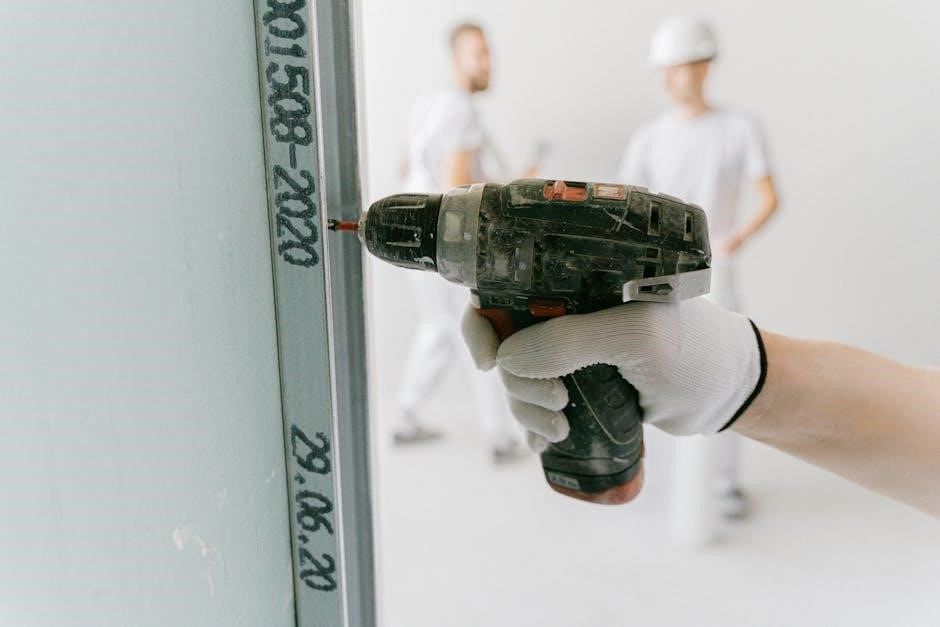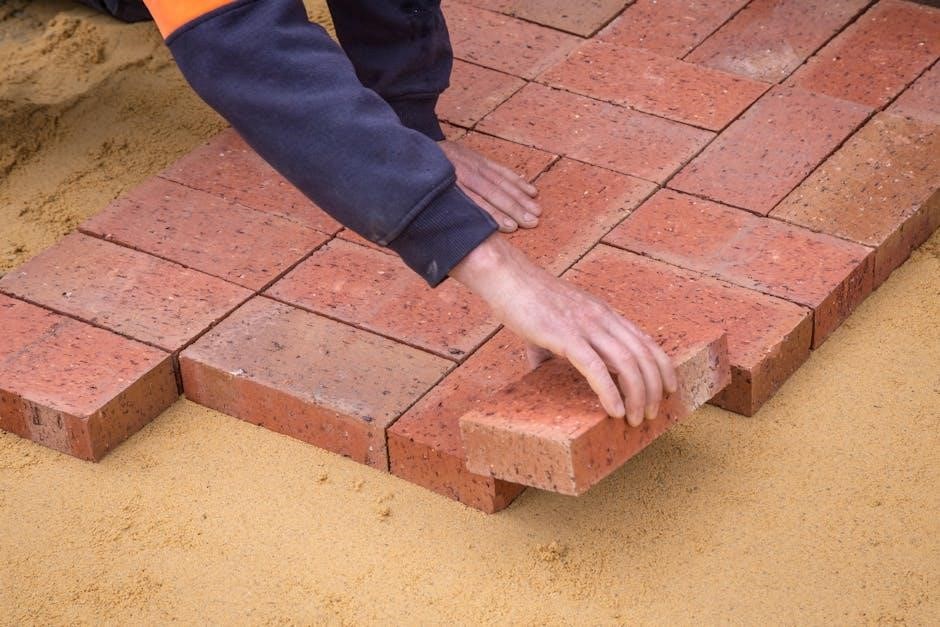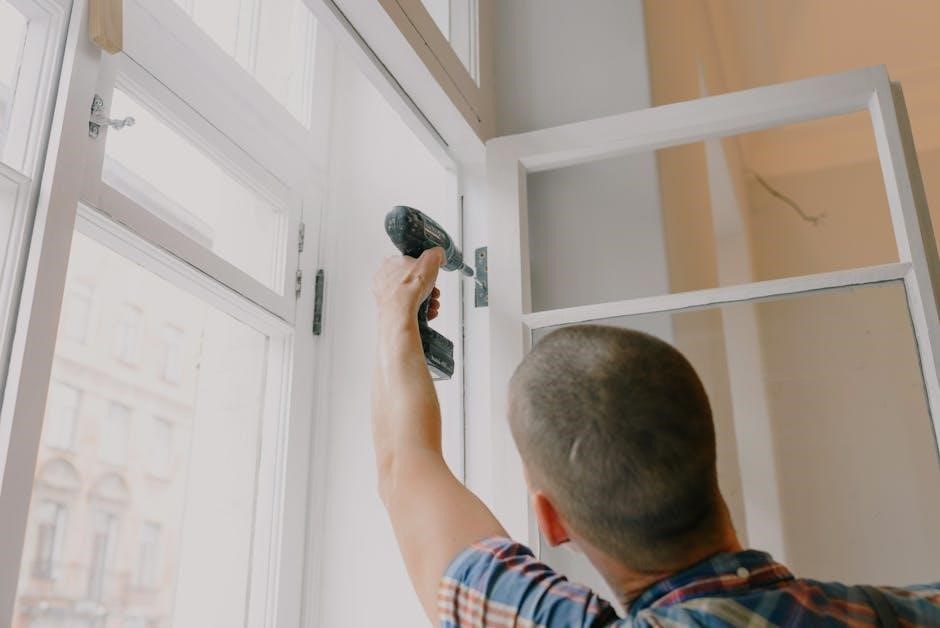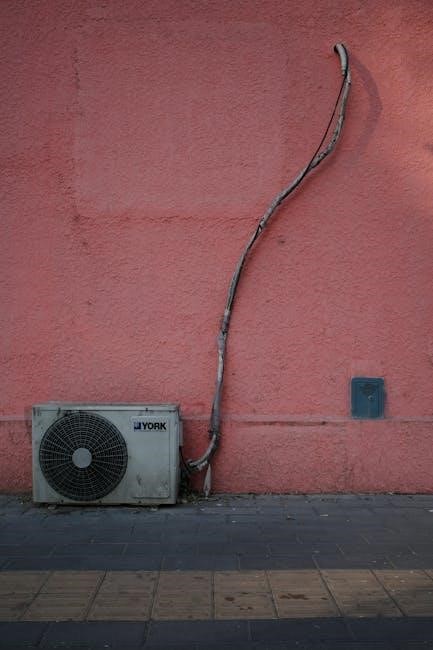This section introduces Mitsubishi mini split systems, emphasizing their efficiency and ease of installation. Proper setup ensures optimal performance, safety, and longevity of the unit. The guide provides a comprehensive overview of the installation process, highlighting key steps and precautions to follow for a successful setup.
1.1 Overview of Mitsubishi Mini Split Systems
Mitsubishi mini split systems are highly efficient, ductless heating and cooling solutions designed for flexibility and energy savings. These systems consist of an indoor unit and an outdoor unit connected by refrigerant lines, offering precise temperature control. Ideal for residential and commercial spaces, they provide quiet operation, space-saving design, and eco-friendly performance. Their adaptability makes them a popular choice for various installation needs, ensuring comfort and reliability in diverse environments.
1.2 Importance of Proper Installation
Proper installation of Mitsubishi mini split systems is crucial for safety, efficiency, and longevity. Incorrect installation can lead to fire hazards, electric shocks, or water leaks, compromising the unit’s performance and lifespan. Adhering to the installation manual ensures optimal functionality, energy efficiency, and reliability. It also prevents potential risks associated with improper setup, such as unit damage or refrigerant leakage, ensuring a safe and comfortable operating environment for years to come.
1.3 Key Components of the Installation Manual
The Mitsubishi mini split installation manual includes essential guidelines, safety precautions, and step-by-step instructions. It outlines required tools, wiring diagrams, and piping connections. The manual also covers troubleshooting tips, maintenance recommendations, and diagnostic procedures. By following the manual, installers can ensure compliance with safety standards, proper system functionality, and optimal performance. Adhering to these components guarantees a secure and efficient installation process for both indoor and outdoor units.

Pre-Installation Preparation
Ensure all necessary tools, like screwdrivers and levels, are gathered. Inspect units for damage and select a suitable location. Plan the layout and safety measures carefully.
2.1 Required Tools for Installation
The installation requires specific tools, including a Phillips screwdriver, level, and utility knife. Additional items like a scale, wrench, and vacuum pump may be needed. Ensure all tools are readily available to streamline the process and avoid delays. Refer to the manual for a detailed list of necessary equipment to complete the installation successfully and safely.
2.2 Selecting the Installation Location
Selecting the right location for your Mitsubishi mini split is crucial for optimal performance. Ensure the area can support the unit’s weight and is free from direct sunlight and moisture. Choose a spot with good air circulation and avoid placing the unit near flammable materials. Proper drainage and accessibility for maintenance should also be considered. Always follow the installation manual’s guidelines for the best results.
2.3 Checking Units for Damage
Before installation, inspect the Mitsubishi mini split units for any visible damage. Check the packaging for dents, scratches, or holes. Verify that all components, including piping and wiring, are included and undamaged. Ensure there are no signs of refrigerant leaks or electrical issues. Refer to the installation manual for specific guidelines on assessing unit condition to guarantee system reliability and safety. Proper inspection ensures a trouble-free installation process.

Safety Precautions
Always turn off power before starting installation. Use proper tools and follow safety guidelines to avoid electric shock or injury. Handle refrigerants safely and ensure proper ventilation. Adhere strictly to the installation manual to prevent accidents and ensure a secure setup.
3.1 Important Safety Notes
Always disconnect power before installation to prevent electric shock. Ensure proper grounding of the system to avoid hazards. Use appropriate tools and wear protective gear. Follow the installation manual carefully to prevent unit damage or personal injury. Never attempt installation without proper training or assistance. Keep the area clear of flammable materials and ensure proper ventilation during the process. Regularly inspect all connections and components for safety compliance.
3.2 Potential Hazards and Risks
Improper installation can lead to fire hazards, electric shocks, or unit malfunctions. Refrigerant leaks pose environmental and health risks. Incorrect mounting may cause the unit to fall, leading to property damage or injury. Inadequate drainage can result in water damage or mold growth. Ignoring safety guidelines increases the risk of accidents and system failure, emphasizing the need for adherence to installation protocols and professional expertise.
3.4 Avoiding Common Safety Mistakes
To ensure a safe installation, avoid common errors such as improper grounding, which can lead to electric shocks. Always follow the manual’s wiring diagrams and tighten connections securely. Never omit safety checks like testing for refrigerant leaks, as this can cause environmental hazards. Ensure the unit is mounted level and securely to prevent falls. Additionally, always use the correct tools and materials specified in the manual to avoid system damage or malfunction.

Installing the Indoor Unit
The indoor unit installation requires careful placement and leveling to ensure proper airflow. Use a Phillips screwdriver and scale to secure the bracket. Follow the manual for precise setup.
4.1 Indoor Unit Installation Location
Selecting the right location for the indoor unit is crucial for optimal performance. Ensure the unit is mounted on a wall with proper structural support to handle its weight. Avoid areas exposed to direct sunlight or excessive moisture. The unit should be at least 3.1 inches away from any obstacles to ensure proper airflow. Additionally, install it in a location that allows easy access for maintenance and servicing. Always follow the manufacturer’s guidelines for placement to ensure efficiency and safety.
4.2 Mounting the Indoor Unit Bracket
Mounting the indoor unit bracket securely is essential for stability. Use appropriate brackets and ensure the wall can support the unit’s weight. Align the unit properly and check it is level. Tighten all screws firmly to prevent any movement; Ensure the bracket is installed according to the manufacturer’s instructions to guarantee safety and optimal performance. Proper installation prevents vibration and noise, ensuring efficient operation. Always verify the unit is level and securely fastened to avoid future issues.
4.3 Connecting Piping and Drainage
Properly connecting piping and drainage is crucial for system efficiency. Ensure all connections are secure and leak-free. Use appropriate tools like utility knives for cutting insulation. Follow the manual’s guidelines to avoid defects, which could lead to water leaks. Check for any blockages or kinks in the drainage system. Securely fasten all pipes and ensure proper drainage slope. Verify that refrigerant lines are tightly connected to prevent gas leaks. Proper installation ensures optimal performance and prevents water damage or system malfunctions.

Outdoor Unit Installation
Installing the outdoor unit requires careful preparation and adherence to safety guidelines. Ensure the unit is placed on a stable, level surface that can support its weight. Properly connect refrigerant lines and ensure secure drainage. Follow the installation manual to avoid leaks or damage. Secure the unit firmly to prevent movement and vibration for optimal performance.
5.1 Preparing the Outdoor Unit
Preparing the outdoor unit involves checking for damage and ensuring all components are intact. Remove packaging materials and inspect the unit for any signs of wear or tears. Verify that all connectors and ports are clean and free from debris. Refer to the installation manual for specific preparation steps to ensure the unit is ready for installation. Proper preparation ensures smooth installation and optimal performance.
5.2 Selecting the Outdoor Unit Location
Selecting the right location for the outdoor unit is crucial for optimal performance and longevity. Ensure the unit is installed on a firm, level surface away from direct sunlight and shaded areas. Avoid locations with standing water or excessive humidity; The unit should be at least 12 inches above the ground to prevent water ingress. Keep it away from flammable materials and ensure proper airflow around the unit for efficient operation and noise reduction.
5.3 Connecting the Refrigerant Lines
Connecting the refrigerant lines requires precision to ensure proper system operation. Use a flare nut wrench and tube cutter for precise cuts and flares. Ensure lines are free from debris and moisture. Connect the suction and discharge lines securely, following the manual’s diagrams. After connection, perform a vacuum test to remove air and moisture. Finally, check for leaks using a refrigerant leak detector to ensure system integrity and efficiency. Proper connections are vital for optimal performance and safety.

Wiring and Electrical Connections
Follow the wiring diagram for secure connections. Use solid conductors (Min. AWG14) and tighten screws firmly. Ensure proper grounding to prevent electrical hazards and ensure system safety.
6.1 Wiring Connections and Diagrams
Refer to the wiring diagram in the manual for precise connections. Ensure all wires, including the ground wire, are securely connected using solid conductors (Min. AWG14). Tighten screws firmly to prevent loose connections. Adhere to the diagram to avoid electrical issues, ensuring power supply lines are correctly linked to the unit’s terminals. Double-check connections to prevent short circuits or system malfunctions. Proper wiring ensures safe and efficient operation.
6.2 Grounding the System
Proper grounding is essential for safety and performance. Use a solid copper wire (Min. AWG14) to connect the unit to a grounded electrical outlet or the main panel. Ensure the ground wire is securely attached to the designated terminal on the outdoor and indoor units. Improper grounding can lead to electric shock, fire hazards, or system malfunction. Always follow the manual’s instructions for correct grounding procedures to ensure safe and reliable operation.
6.3 Electrical Safety Measures
Adhere to electrical safety guidelines to prevent hazards. Ensure all connections are tight and meet local codes. Use appropriate circuit breakers and fuses. Never modify the unit’s wiring or components. Keep power sources away from water and flammable materials. Regularly inspect wires for damage. Turn off the power supply before servicing. Always follow the installation manual’s electrical safety recommendations to minimize risks and ensure a safe operating environment.

Testing and Commissioning
After installation, perform initial startup to ensure proper operation. Check for refrigerant leaks and verify all system functions, ensuring optimal performance and safety standards are met.
7.1 Initial Startup and Testing
Power up the system and check for proper operation. Ensure all components function correctly, including cooling, heating, and airflow. Verify there are no refrigerant leaks and that drainage systems work efficiently. Test remote control operation and ensure temperature settings respond accurately. Refer to the manual for specific startup procedures to guarantee safe and efficient system performance.
7.2 Checking for Refrigerant Leaks
After installation, inspect all refrigerant connections for leaks using a leak detector. Ensure joints are tightly sealed and verify system pressure. Avoid using soapy water, as it may damage components. Properly functioning refrigerant lines are crucial for efficient cooling and heating. Any detected leaks must be promptly repaired to prevent system malfunction and ensure optimal performance.
7.3 Verifying System Performance
After installation, start the system and test its cooling and heating modes to ensure proper operation. Check airflow from vents and verify temperature settings are accurate. Look for any unusual noises or vibrations, which could indicate issues. Confirm that the system reaches the set temperature and maintains it steadily. Proper functionality ensures reliability, efficiency, and longevity of the Mitsubishi mini split system.

Final Checks and Documentation
Conduct a visual inspection to ensure all connections are secure and the system is properly installed. Verify functionality and update installation records for future reference and maintenance.
8.1 Conducting a Visual Inspection
After installation, perform a thorough visual inspection to ensure all components are correctly installed. Check for any signs of damage, proper securing of brackets, and secure connections of piping and drainage. Verify that the unit is level and properly aligned. Ensure all safety measures, such as grounding, are in place. Review the installation area to confirm it is clear of debris. This step ensures the system is installed safely and functions optimally, preventing future issues. Update records with inspection details;
8.2 Ensuring Proper Functionality
After completing the installation, turn on the unit and test all modes to verify proper functionality. Check cooling, heating, and fan operations to ensure smooth performance. Verify that airflow is unrestricted and the system responds correctly to remote control commands. Inspect refrigerant lines for leaks and ensure proper drainage. Confirm that electrical connections are secure and functioning as intended. Address any irregular noises or performance issues promptly to ensure optimal operation and efficiency. Record any findings for future reference.
8.3 Updating Installation Records
After completing the installation, update all relevant records with details of the setup, including model numbers, serial numbers, and installation dates. Document any specific settings or configurations made during the process. Ensure compliance with manufacturer guidelines and local regulations. Maintain a copy of the installation manual and records for future reference or maintenance needs. Accurate documentation helps track system performance and ensures compliance with warranty terms.

Troubleshooting Common Issues
Identify common problems like refrigerant leaks, drainage issues, or electrical malfunctions. Check for proper connections and ensure units are level. Refer to the manual for solutions.
9.1 Identifying Common Installation Problems
Common issues include refrigerant leaks, improper drainage, and electrical misconnections. Units may malfunction if not installed level or securely. Incorrect wiring can lead to system failure. Ensure all components are tightly sealed and connections are precise. Verify that the outdoor unit is placed on a stable base to prevent vibration. Always refer to the manual for specific troubleshooting guidance to address these problems effectively.
9.2 Diagnostic Tips and Solutions
For diagnostic troubleshooting, check error codes on the remote control. Ensure proper power supply and inspect wiring connections. Refrigerant leaks can be detected using specialized tools. If the unit isn’t cooling, verify refrigerant levels and check for blockages in air filters or coils. Drainage issues may require adjusting the unit’s elevation. Always follow the installation manual’s guidelines for precise solutions to maintain system efficiency and prevent further complications. Regular maintenance can prevent many common issues.
9.3 When to Call a Professional
If you encounter complex issues like refrigerant leaks, electrical malfunctions, or system incompatibility, consult a certified HVAC technician. Improper handling of refrigerants or wiring can lead to safety hazards. Professional expertise ensures compliance with safety standards and manufacturer guidelines. For multi-unit installations or advanced troubleshooting, rely on experienced installers to guarantee optimal performance and avoid potential risks associated with improper setup.

Maintenance and Longevity
Regular maintenance is key to extending the lifespan of your Mitsubishi mini split. Clean air filters, inspect drainage, and ensure proper functionality. Schedule annual professional servicing to maintain efficiency and performance.
10.1 Scheduling Regular Maintenance
Regular maintenance ensures optimal performance and longevity of your Mitsubishi mini split system. Schedule professional servicing annually to inspect components, clean filters, and check refrigerant levels. Additionally, plan seasonal checks to prepare for extreme temperatures. A well-maintained system operates efficiently, reducing energy costs and preventing unexpected breakdowns. Always refer to the installation manual for specific maintenance recommendations tailored to your unit.
10.2 Cleaning and Servicing the Unit
Regular cleaning and servicing are crucial for maintaining the efficiency and performance of your Mitsubishi mini split system. Clean air filters monthly to ensure proper airflow and energy efficiency. Inspect and clean the indoor and outdoor unit coils to prevent dust buildup. Check refrigerant lines for damage or leaks and ensure proper drainage. Use a soft brush or vacuum to clean components, avoiding harsh chemicals. Professional servicing is recommended annually to address complex issues.
10.3 Ensuring Optimal Performance
To ensure optimal performance, maintain consistent maintenance schedules and monitor system operations. Regularly check refrigerant levels and ensure proper airflow through vents. Address any blockages promptly to prevent reduced efficiency. Keep the surrounding area clear of debris to maintain proper heat exchange. Schedule professional inspections annually to identify and resolve potential issues before they affect performance. Proper care ensures consistent comfort and extends the system’s lifespan.
Proper installation and maintenance ensure efficiency, safety, and optimal performance of Mitsubishi mini splits. Adhering to the manual guidelines guarantees reliable operation and extends system longevity effectively.
11.1 Summary of Key Installation Steps
Proper installation of Mitsubishi mini splits involves selecting suitable locations, ensuring level mounting, and securely connecting piping and electrical components. Always refer to the manual for specific instructions, and verify refrigerant lines for leaks. Safety precautions, such as avoiding improper grounding, are critical to prevent hazards. Completing all steps meticulously ensures efficient operation, reduces risks, and prolongs system lifespan. Adherence to guidelines guarantees optimal performance and reliability.
11.2 Final Tips for a Successful Installation
Always follow the installation manual carefully and ensure all safety precautions are met. Use the correct tools, such as a Phillips screwdriver and level, to secure the unit properly. Double-check for any damage or leaks post-installation. Test the system thoroughly to ensure optimal performance. Avoid installing the unit yourself and consult a professional if unsure. Proper maintenance and regular checks will extend the system’s lifespan and efficiency.
